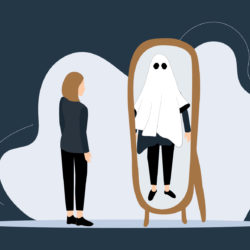There are many identities that can be found within the spectrums of sexual orientations or gender identitites. Some people are able to identify themselves and their sexual orientation easily. For others, however, discovering who you are and how you identify can be a long-term journey based on their personal experiences.
Our ability to develop new terminology to better describe how we feel, what we like, and who we’re drawn to has also improved as our language about identity evolves. This is particularly true for the asexual population.
In the past decade, we have gained a better understanding of what being asexual means. This has led to the creation of a variety of identities, which are defined by our sexual attraction, and its relationship to our romantic desire, relationships and sexual desire. Understanding the various identities that we have is important for our mental and emotional health as well as the overall wellbeing of ourselves, friends, family and members of our communities. It is especially important to note that historically, medical education has excluded LGBTQIA+-related health content as a result discrimination.
“Asexuality can be a bit nebulous”, says Gina Rhodes , PhD. “Asexuality has its own spectrum, and it looks at both sexual attraction and romantic attraction.”
Dr. Rhodes explores what it means to have an asexual orientation, paying particular attention to how we speak about attraction in general.
What does asexuality mean?
Asexuality, also known as “ace,” is a term that describes anyone who feels little or no sexual attraction to other people. Asexuality is a complex issue that can be influenced by our relationships, our definitions of sexual attraction, romance and aesthetic attraction.
In modern society they are often confused as if they were two separate things.
Sexual attraction is defined as the desire to touch someone in a sexually intimate manner. Sexual attraction can occur without romantic feelings.
The desire to feel a close, loving connection with another person can be described as romantic attraction. Romantic attraction is possible without ever feeling sexual attraction. It relies on the close emotional connection. You can be an aromantic. This means that you might not feel romantic attraction towards other people, regardless of gender.
There’s also aesthetic attraction. This is defined as admiration for someone’s appearance or beauty without sexual or romantic attraction.
Asexual people may be more attracted to people by their aesthetic or romantic appeal, but not sexually.
Dr. Rhodes says that it looks different for each person. For some, this means that they have a romantic relationship with someone but it may not include sexual contact. It could also mean other types of intimate contact such as cuddling. Or, the sexual contact could be there but not strongly felt by the asexual partner.
Asexuals may engage in sex to demonstrate their care rather than as an investment.
Asexuality is often misunderstood. This is often confused with loss libido. Asexuality is often mistaken for a medical disorder that can be treated or cured. Some people think that asexuality can be compared to celibacy and abstinence. The dangerous assumption that someone may identify as asexual if they have experienced sexual trauma or physical abuse is another danger. Dr. Rhodes warns, however, that these myths are often false and can be harmful.
“Associating trauma with asexuality is harmful, because for many people this was a discovery process rather than a thing that they were forced to do,” explains Dr. Rhodes. The assumption that someone’s identity was a result trauma can take away from the agency and hardwork that person has done to accept their asexuality, especially in a culture that values sexual and romantic attraction.
Asexuality, unlike celibacy and abstinence – which are temporary decisions made based on circumstances or beliefs – is an identity, a state of mind and an orientation. It’s not something you can choose.
Dr. Rhodes says that “asexuality is more persistent.”
Types asexuality
Asexuality is fluid, just like all other sexual orientations. Asexuals may experience different levels of sexual attraction over the course of their lives and from one relationship to another. A person may define themselves as “asexual”. In order to define the different degrees of asexuality, there are several subgroups and categories.
This list isn’t exhaustive, but it does include some asexual identities that you should be aware of.
Aceflux
This identity describes someone who’s sexual orientation changes but stays in the asexual range. This identity could be you if, for example, you don’t usually desire sexual activity but occasionally do.
“Asexuality is something that can change as people get to know themselves and see what relationships are like,” Dr. Rhodes says. It’s something which can change for many people.
Demisexual
You may find someone sexually appealing if you have developed an emotional connection or romantic relationship with them. You will not experience sexual attraction if you do not have an emotional or romantic relationship. Many people who identify themselves as demisexual may wait to engage in sexual activity until after they have developed an emotional and romantic bond.
Fraysexual
Fraysexual people may initially feel sexual attraction, but this will fade over time as they form an emotional connection. This identity is the opposite of demisexual.
Graysexual
Graysexuals are in the gray area between wanting to have sexual activity and not wanting it. If you only experience limited sexual attraction, and this is not frequent, then you may be a graysexual. You may feel sexual attraction but it is not strong enough for you to act on it.
Lithosexual
This sexual orientation is for people who are sexually attracted to other people but do not want to be sexually attracted back. You might be uncomfortable with the idea that someone finds you sexually appealing and lose your feelings if those feelings are reciprocated. You may be hesitant to seek out sexual relationships for these reasons.
What is the best way to tell if you are asexual?
Reflecting on your personal experiences and feelings is the first step to discovering your identity. You may find it helpful to ask yourself some questions as you go along.
- What is sexual attraction for me?
- How has my sexual desire manifested itself in my life?
- What is my identity to me?
- What would it mean to me if I changed my identity?
- What would it mean to me if I had a new identity?
- Do I wish to change my sexual and romantic relationships in any way?
- What aspects of your identity would you like to share with loved ones?
Dr. Rhodes says that many people begin their journey by learning more about asexuality, and deciding what label they feel most comfortable with. “My advice is to connect with other asexuals and asexuals groups to hear their stories of coming to terms with identity. It is important to learn from other people about their journeys.
How you can talk about your asexuality with your family and friends
You decide when and how to tell people you love that you are asexual. Your decision on how to come out will depend on your feelings about physical safety, emotional and mental well-being. It’s okay if you aren’t ready. Coming out is different for everyone.
If you are prepared to share the information with your audience, it may be a good idea to ask them what they know about asexuality.
“Start by asking what they know,” says Dr. Rhodes. Ask, “What do you already know about asexuality? What do you make of the idea that romantic and sexual attraction can be different for each person?
You can learn more about their knowledge and how they perceive your identity by opening up the conversation. Your identity can change over time based on your feelings and the relationships you have. It’s important that you and your loved ones remember and acknowledge the fact that sexuality and asexuality are on a continuum. It’s okay to change who you are.
“Identity isn’t a game of chance.” “If someone’s identity changes, or flexes,” it is influenced by the person’s experience,” says Dr. Rhodes. When people tell you what they are, it is important to believe them.





















